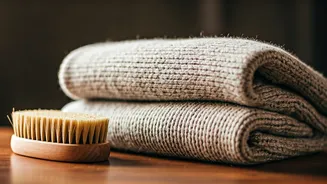Dose: Proper Washing
The first step in proper care is understanding how to wash your woollen garments. Always check the care label before washing; this is the most crucial
piece of advice. If the label says 'dry clean only,' then dry cleaning is essential to preserve the fabric's integrity. For machine-washable items, use a gentle cycle with cold water, which is gentler on the wool fibres and prevents shrinking. Choose a mild detergent specifically designed for wool or delicate fabrics. Avoid harsh detergents as they can strip the natural oils, making the wool feel rough and causing damage. Turn the garments inside out to protect the outer surface from friction and damage during washing. Once the wash cycle is complete, do not wring or twist the clothes, as this can distort their shape.
Do: Careful Drying
Drying woollen clothes correctly is as important as washing them properly. Never put woollens in a machine dryer; the heat will cause them to shrink and ruin their shape. Instead, lay them flat on a clean, dry surface, ideally on a drying rack. Ensure the item is spread out evenly to maintain its shape. Avoid direct sunlight or heat, as this can fade colours and damage the fibres. Rotate the garment occasionally to ensure even drying, which helps prevent any warping or stretching. You may need to reshape the item gently while it's still damp to restore its original form, especially for sweaters or other knitted items. Patience is key; allow your woollens to air dry completely to avoid any lingering moisture that could lead to mildew or odours.
Do: Smart Storage
When it's time to store your woollens, proper preparation and environment are crucial for their long-term preservation. Before storing, ensure the clothes are clean and completely dry to prevent attracting moths and mildew. Fold the items neatly; hanging woollens can stretch them out of shape. Use breathable storage containers such as cotton bags or boxes. Avoid plastic bags, which can trap moisture. Add cedarwood balls or lavender sachets to your storage containers; these natural repellents can deter moths and keep your clothes smelling fresh. Store your woollens in a cool, dry place away from direct sunlight and heat. Regularly check your stored items for any signs of moth damage or other issues. If you do find any, address them immediately by cleaning the affected garment and treating the storage area.
Don't: Harsh Detergents
Using the wrong type of detergent is a common mistake that can significantly damage woollen garments. Avoid detergents containing enzymes, bleach, or harsh chemicals. These ingredients can weaken the wool fibres, leading to fading, shrinking, and a rough texture. Opt for a mild detergent specifically designed for wool or delicate fabrics. These detergents are formulated to clean gently without stripping away the natural oils that keep the wool soft and flexible. If you're unsure, it's always best to err on the side of caution. Consider using a neutral pH detergent to minimise the risk of damage. Always follow the detergent's instructions, and never use more than the recommended amount. Overuse can leave residue that attracts dirt and affects the garment's appearance.
Don't: Hang Woollens
Hanging woollen items, particularly sweaters and knitted garments, is a big no-no, as it can cause them to lose their shape and stretch out. The weight of the garment can pull on the fibres, leading to misshapen shoulders and a generally distorted appearance. Instead of hanging, fold your woollens neatly and store them flat. This method helps maintain their original form and prevents any unwanted stretching. If you must hang a wool item, like a heavy coat, use padded hangers to minimise pressure on the shoulders. Even then, folding remains the preferred storage method. Proper storage not only preserves the garment's shape but also extends its lifespan, allowing you to enjoy your favourite woollen pieces for many seasons.












